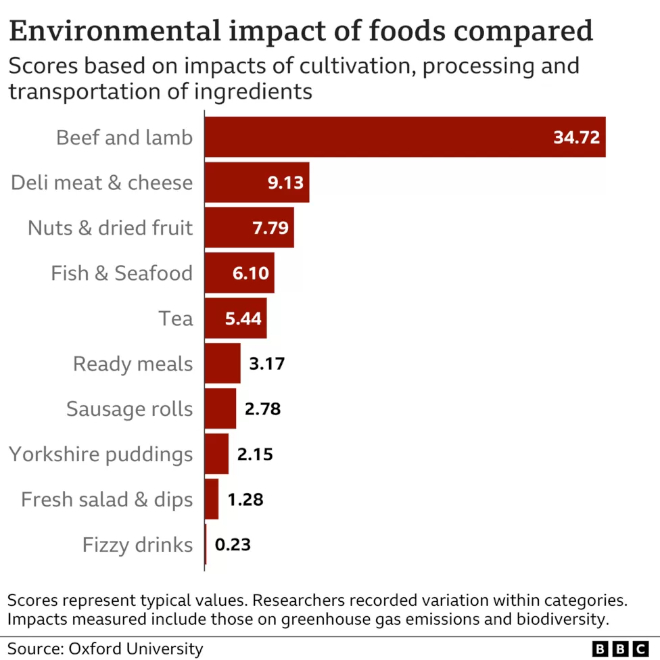We’ve long had a quantitative handle on how good or bad for us packaged and processed foods are for our bodies. It’s led to prominent posting ingredient lists and nutrition ‘ratings’ on packages. Enviro-labelling may be next…
 A sampling of surprising and not-so-surprising results of the Oxford study…
A sampling of surprising and not-so-surprising results of the Oxford study…
Researchers at Oxford University have completed a mammoth exercise in data mining that has produced a tool to calculate the environmental impact of processed foods.
What they did
According to a recent BBC article: “The Oxford team estimated the composition of 57,000 foods and drinks in supermarkets in the UK and Ireland. It then assessed the impact of growing methods, processing and transport, against key environmental measures including greenhouse gas emissions and impacts on nature. […] The team developed an algorithm to calculate an eco-score for the environmental impact of individual food and drink products.”
What they found
They found, basically, that it was possible to put reliable quantitative values on the heretofore subjective impacts of production, transportation and sale of packaged, processed foods.
Among their key findings:
- Not surprisingly, production of beef and lamb, deli meats and cheese, and fish/seafood topped the list of highest impact foods.
- Surprisingly (to some), nuts and tea were also in the top 5.
- Not surprisingly: fresh salads and and dips were among the least impactful.
- Surprisingly: Yorkshire Puddings and sausage rolls were also among the lowest-impact foods.
For sure, there’s no clear correlation between the enviro-impact and healthfullness of foods. A finding that will make some folks question their earlier perceptions of ‘healthy’ and ‘unhealthy’ foods, when they take the environmental factors into account.
The takeaway
Using the Oxford algorithm, manufacturers can now tweak their recipes to lower the overall environmental impacts of their products.
Consumers can now gauge the relative impacts of one type or brand of (say) sausage against another.
The availability of objective numerical measurements can help governments formulate recommendations for what to produce and what not to produce; what to eat and what not to eat.
My take
The BBC story stresses, “The researchers don’t foresee [enviro-labelling] becoming compulsory in the near future. They want firms to adopt it voluntarily, something they believe would lead them to compete over the sustainability of their food and drink products.” The voluntary approach has not worked well in the past when business and industry decided it was going to cost them too much money, time or effort to comply. We’ll see.
Nevertheless…
Prof Peter Scarborough of Oxford University told BBC News: “The food industry has also been, ‘crying out’ for the new tool and that the algorithm is already being used by some manufacturers and caterers. “It fills a huge gap. Manufacturers, caterers and retailers have targets for reaching net zero [emissions] and they don’t have the tools they need to get there.”
And that’s all good.
My final words
Even though the potential for making important impacts on the environmental crisis is clear, it remains to be seen whether industry will embrace the new tool it has been given.
And let’s not forget the environmental impacts of power generation, automobiles and other major activities. They still far outweight that of agriculture in the big picture. Let’s get working, in earnest, on those, too.
~ Maggie J.

